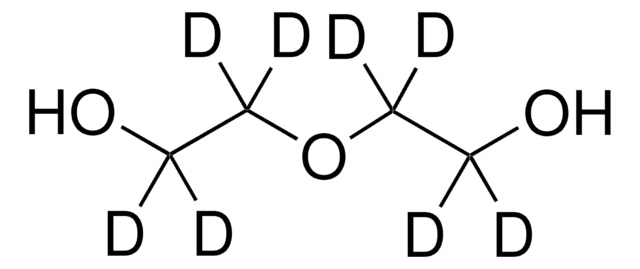93171
Dietilenglicole
BioUltra, ≥99.0% (GC)
Sinonimo/i:
2,2′-ossidietanolo, 2-idrossietil etere, Bis(2-idrossietil) etere, Diglicole
About This Item
Prodotti consigliati
Densità del vapore
2.14 (vs air)
Tensione di vapore
0.01 mmHg ( 20 °C)
Descrizione
non-ionic
Nome Commerciale
BioUltra
Saggio
≥99.0% (GC)
Forma fisica
liquid
viscous liquid
Temp. autoaccensione
442 °F
Limite di esplosione
2-12.3 %
Impurezze
insoluble matter, passes filter test
≤30 mg/kg peroxides (as H2O2)
Indice di rifrazione
n20/D 1.447 (lit.)
n20/D 1.447
pH
5.5-7.0 (25 °C, 50 mg/mL in H2O)
P. eboll.
245 °C (lit.)
Punto di fusione
−10 °C (lit.)
Solubilità
H2O: 50 mg/mL at 20 °C, clear, colorless
Densità
1.118 g/mL at 25 °C (lit.)
Anioni in tracce
chloride (Cl-): ≤50 mg/kg
sulfate (SO42-): ≤50 mg/kg
Cationi in tracce
Al: ≤10 mg/kg
As: ≤0.1 mg/kg
Ba: ≤5 mg/kg
Bi: ≤5 mg/kg
Ca: ≤10 mg/kg
Cd: ≤5 mg/kg
Co: ≤5 mg/kg
Cr: ≤5 mg/kg
Cu: ≤5 mg/kg
Fe: ≤5 mg/kg
K: ≤200 mg/kg
Li: ≤5 mg/kg
Mg: ≤5 mg/kg
Mn: ≤5 mg/kg
Mo: ≤5 mg/kg
Na: ≤200 mg/kg
Ni: ≤5 mg/kg
Pb: ≤5 mg/kg
Sr: ≤5 mg/kg
Zn: ≤5 mg/kg
Stringa SMILE
OCCOCCO
λ
50 mg/mL in H2O
Assorbanza UV
λ: 260 nm Amax: ≤0.060
λ: 280 nm Amax: ≤0.030
InChI
1S/C4H10O3/c5-1-3-7-4-2-6/h5-6H,1-4H2
MTHSVFCYNBDYFN-UHFFFAOYSA-N
Cerchi prodotti simili? Visita Guida al confronto tra prodotti
Applicazioni
Avvertenze
Warning
Indicazioni di pericolo
Consigli di prudenza
Classi di pericolo
Acute Tox. 4 Oral
Codice della classe di stoccaggio
10 - Combustible liquids
Classe di pericolosità dell'acqua (WGK)
WGK 1
Punto d’infiammabilità (°F)
280.4 °F - closed cup
Punto d’infiammabilità (°C)
138 °C - closed cup
Dispositivi di protezione individuale
Eyeshields, Faceshields, Gloves, type ABEK (EN14387) respirator filter
Certificati d'analisi (COA)
Cerca il Certificati d'analisi (COA) digitando il numero di lotto/batch corrispondente. I numeri di lotto o di batch sono stampati sull'etichetta dei prodotti dopo la parola ‘Lotto’ o ‘Batch’.
Possiedi già questo prodotto?
I documenti relativi ai prodotti acquistati recentemente sono disponibili nell’Archivio dei documenti.
I clienti hanno visto anche
Il team dei nostri ricercatori vanta grande esperienza in tutte le aree della ricerca quali Life Science, scienza dei materiali, sintesi chimica, cromatografia, discipline analitiche, ecc..
Contatta l'Assistenza Tecnica.








